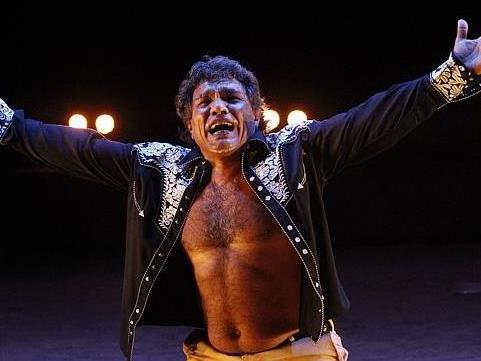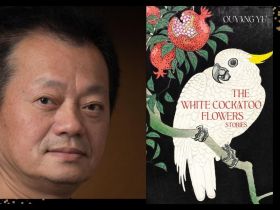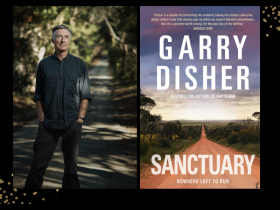Image: The Shadow King, Malthouse Theatre.
Culture is bigger than art
‘The main thing that it’s important to get across is that quite often the word ‘art’ doesn’t fit the bill. Traditionally, we never had a word for what we now call art – it is more important than just an art product’, said Tiriki Onus, Lecturer in Indigenous Arts and Culture at the Wilin Centre for Indigenous Arts and Cultural Development.
‘For Indigenous people, art has been commodified into an important tool for self-determination and independence. Boomerangs were being sold out of tin shacks in the 1940s. Indigenous people created what we now know as art as a means of gaining independence and freedom.’
‘We want to teach non-Indigenous people that these stories are theirs to celebrate too. Indigenous people are the oldest living culture on the planet, and the story is still continuing, and non-Indigenous stories are part of this now. In the past, non-Indigenous people have perhaps not engaged in the most culturally safe way, but we know that non-Indigenous people can find empowerment and knowledge through sharing these stories in a respectful way,’ said Onus.
There’s treasure out there
‘Remote communities are often discussed as a deficit model and I completely disagree. There is such a huge richness out there that when you can start looking at solution based positive opportunities, rather than the other way around, then some really exciting things can happen. There’s also a lot of room for innovation because there isn’t a lot of stuff happening out there that’s happening in the city or other regional centres so you can get really creative and try some really interesting things that you otherwise couldn’t do. The experiences I’ve had as an arts worker and what we’ve been able to develop as far as projects over the years with the community have been a joy to do. They have been very challenging at the same time,’ said Indigenous Traditional Dance Program Coordinator for Artback NT, Lia Pa’apa’a.
‘I think for me, as a non-Indigenous Australian, it’s being able to go in with an open mind and an open heart to what some of those complexities are around Indigenous art. And understanding that you might never know, but what your role is around supporting, facilitation and creating platforms and spaces for people to self-determine and decide for themselves what they want to create and how they want to tell their story.’
Read: Community takes ownership of remote festival
Context is critical
‘We would like non-Indigenous people to understand that remote Aboriginal art is unique with a history different from mainstream art history. It has a traditional history steeped in a different culture, law and meaning. It derives from ancient tradition in ochres, rock, sand, water and is symbolic and ritualistic in origin. There is indivisibility of Aboriginal art forms – dance, painting, language, story, music – traditionally one form doesn’t exist fully without the other,’ said Executive Officer of Barkly Regional Arts Alan Murn.
‘The work we do in partnership with remote Aboriginal people should be appreciated for the context. The journey of an arts work from very remote communities to the consumer is a journey through extremes: extreme geography, climate, disadvantage, health, economic and social challenges. From a hard place comes work of great warmth, knowledge and richness. BRA is proud to be part of that journey.’
Read: Taking the gallery system to the artist
Language is culture
In 2014 Central Australian Aboriginal Media Association (CAAMA) produced the documentary Talking Language with Ernie Dingo. In the series Dingo explores how Indigenous languages and dialects are revived and maintained across Australia. The documentary educates audiences on the 250 Indigenous languages (with 600 dialects) that are spoken in Australia, although only 30 of those languages are still spoken daily.
CAAMA said that many people don’t appreciate that any Aboriginal language exists at all, let alone know that many of these languages are spoken daily. ‘A large part of CAAMA Productions work (our department makes TV and films) is carried out to maintain languages and culture,’ said a CAAMA spokesperson.
Read: The voice of Aboriginal Australia
It’s a two-way process
‘The activity has to be relevant and designed in conversation with the people we work with. Work in remote Indigenous communities is rewarding, hard, life changing, and challenging – personally and artistically but it demands that artists arrive with an openness about the journey,’ said Jane Tonkin, Executive Producer of Corrugated Iron Youth Arts.
‘Artists will sometimes arrive with an expectation that they can problem solve, however arriving with an expectation of exchange and a willingness to change tack (good tenets of community arts practice perhaps!) will result in extensive learning for all involved.’
Read: How to make a creative space for young people
Culture owners must lead the process
‘I would like people to know Aboriginal art and culture is diverse and expressed through a broad range of platforms. Every Aboriginal voice is unique to tell their stories – it is Aboriginal arts led, and Aboriginal arts owned, and they are the stories told by Aboriginal people,’ said Sharni Jones, Senior Aboriginal Cultural Development Officer of Arts NSW.
‘For non-Aboriginal people, whether engaged in the sector or not, it is all our responsibilities – If companies want to engage with Aboriginal story telling they need to bring in the appropriate voices.’
Read: NSW Strategy champions Aboriginal arts and cultural leaders
Cultural expression comes in many forms
‘I would love a better recognition of our cultural expression. That might manifest itself in our language, or in our tools, or in the objects that we’ve made, or in our knowledge or understanding of environment. I think that sophistication still plays out today in other ways and I would just love to see that understood as a continuation,’ said ACCELERATE participant, curator Jilda Andrews.
Read: Bold visions for future Indigenous arts leaders
Different regions, different art
‘The Indigenous art movement started in Central Australia fifty years ago and we have only been operating for as short as five years and every other part of Australia has had a peak body for up to thirty years. The support is very new and the art centres themselves are relatively new, ten years old at the most. So Queensland art hasn’t been much on the market,’ said Pamela Bigelow, Manager of the Indigenous Art Centre Alliance (IACA).
‘But Queensland art is its own work, it’s very different from the desert work and is not dots at all. So the expectation that it will look like desert work is something that we come up against a lot. People don’t get that it is a whole different region. Physically, it’s unique in country in terms of the rainforest and the environment. There’s nowhere else like it in Australia and that’s reflected in the work. It’s rather bright, as opposed to the muted tones of some desert work.’
Read: Why remote art centres matter
Audiences respond to diverse and challenging Indigenous arts
Following the recent publication of the Showcasing Creativity research, the Australia Council spoke to ArtsHub about the barriers that are hindering more programming of First Nations work in Australian theatres and festivals.
Read: How to increase First Nations performing arts programming
The research found that although audiences thought of Indigenous arts in terms of traditional work, some of the most successful works dealt with difficult contemporary issues in distinctly non-traditional formats.
‘There are tokenistic decisions about finding suitable works, and what people think may well be their match with their current audience but we are saying that those kinds of assumptions around what your audience would engage with is what you need to test as a presenter and programmer,’ said Lydia Miller, Executive Director Aboriginal and Torres Strait Islander Arts, Australia Council for the Arts.
Read: Cultural highways lead to Venice for First Nations curators





